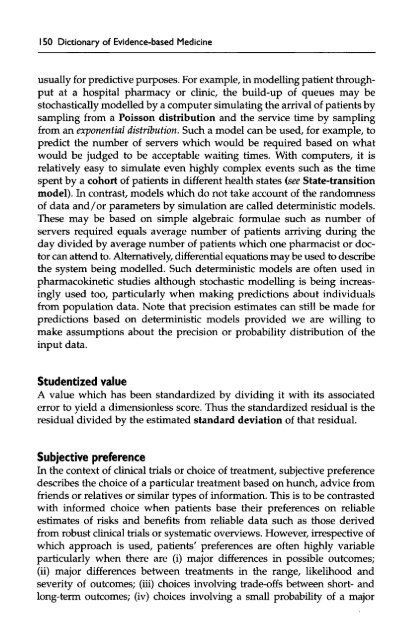Dictionary of Evidence-based Medicine.pdf
Dictionary of Evidence-based Medicine.pdf
Dictionary of Evidence-based Medicine.pdf
You also want an ePaper? Increase the reach of your titles
YUMPU automatically turns print PDFs into web optimized ePapers that Google loves.
150 <strong>Dictionary</strong> <strong>of</strong> <strong>Evidence</strong>-<strong>based</strong> <strong>Medicine</strong><br />
usually for predictive purposes. For example, in modelling patient throughput<br />
at a hospital pharmacy or clinic, the build-up <strong>of</strong> queues may be<br />
stochastically modelled by a computer simulating the arrival <strong>of</strong> patients by<br />
sampling from a Poisson distribution and the service time by sampling<br />
from an exponential distribution. Such a model can be used, for example, to<br />
predict the number <strong>of</strong> servers which would be required <strong>based</strong> on what<br />
would be judged to be acceptable waiting times. With computers, it is<br />
relatively easy to simulate even highly complex events such as the time<br />
spent by a cohort <strong>of</strong> patients in different health states (see State-transition<br />
model). In contrast, models which do not take account <strong>of</strong> the randomness<br />
<strong>of</strong> data and/or parameters by simulation are called deterministic models.<br />
These may be <strong>based</strong> on simple algebraic formulae such as number <strong>of</strong><br />
servers required equals average number <strong>of</strong> patients arriving during the<br />
day divided by average number <strong>of</strong> patients which one pharmacist or doctor<br />
can attend to. Alternatively, differential equations may be used to describe<br />
the system being modelled. Such deterministic models are <strong>of</strong>ten used in<br />
pharmacokinetic studies although stochastic modelling is being increasingly<br />
used too, particularly when making predictions about individuals<br />
from population data. Note that precision estimates can still be made for<br />
predictions <strong>based</strong> on deterministic models provided we are willing to<br />
make assumptions about the precision or probability distribution <strong>of</strong> the<br />
input data.<br />
Studentized value<br />
A value which has been standardized by dividing it with its associated<br />
error to yield a dimensionless score. Thus the standardized residual is the<br />
residual divided by the estimated standard deviation <strong>of</strong> that residual.<br />
Subjective preference<br />
In the context <strong>of</strong> clinical trials or choice <strong>of</strong> treatment, subjective preference<br />
describes the choice <strong>of</strong> a particular treatment <strong>based</strong> on hunch, advice from<br />
friends or relatives or similar types <strong>of</strong> information. This is to be contrasted<br />
with informed choice when patients base their preferences on reliable<br />
estimates <strong>of</strong> risks and benefits from reliable data such as those derived<br />
from robust clinical trials or systematic overviews. However, irrespective <strong>of</strong><br />
which approach is used, patients' preferences are <strong>of</strong>ten highly variable<br />
particularly when there are (i) major differences in possible outcomes;<br />
(ii) major differences between treatments in the range, likelihood and<br />
severity <strong>of</strong> outcomes; (iii) choices involving trade-<strong>of</strong>fs between short- and<br />
long-term outcomes; (iv) choices involving a small probability <strong>of</strong> a major










